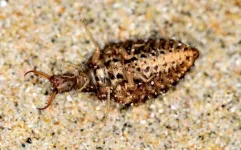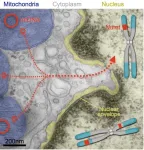(Press-News.org) A new study led by scientists from the University of Bristol has revealed what animals do after they have feigned death in order to avoid being killed by a predator and what the context of this behaviour is.
Many animals, as a last-ditch defence, become motionless after being contacted by a predator.
This behaviour is so common that it's recognised in such phrases as “playing possum”. It is even said to occur in humans in extreme circumstances.
In previous studies, carried out by the same team using antlion larvae, scientists noticed that they become motionless after being individually handled.
At one point the larvae needed to be weighed, which with such small insects can be very difficult, if they move on the pan of the weighing balance, determining their mass can be a challenge.
However, when the antlion larvae were dropped, very gently, onto the pan of a weighing balance, they remained completely stationary for more than enough time for their weight to be recorded accurately.
Emeritus Professor Nigel Franks from the University of Bristol’s School of Biological Sciences, who led the study, said: “We chose to investigate this so-called ‘death-feigning’ behaviour and we found that the amount of time individual antlions remain stationary is completely unpredictable for any one individual.
“This is confirmed by looking at the durations of post-contact immobility in a large number of antlions. Such data shows an exponential distribution. So just as with radioactive atoms, when an individual changes state is unpredictable, but the population pattern is perfectly predictable.”
The study shows that the behaviour of antlions hiding in plain sight, in this way, is likely to be adaptive because a predator having picked up and then dropped an antlion larva could not know how long to wait for its potential victim to move again and once more become a recognisable prey item. Indeed, one of the antlions recorded remained completely stationary for more than an hour.
Even though it cannot be predicted when a motionless antlion will spring back to life this does not mean that the predator will necessarily have left the scene to look for alternative prey.
The team’s next question was what animals do after playing possum. In the new study, they show that what antlions do depends on the situation in which they find themselves.
Antlion larvae are burrowing animals and might seek safety in submerging into the friable substrate where they normally build their pits. But it is quite possible that a predator might drop an antlion on to a hard substrate that wouldn't permit escape through borrowing.
By using sophisticated automated video tracking of the intermittent locomotion of individual antlions on different substrates researchers found that what an antlion does after terminating its period of motionlessness depends on what escape strategies are available.
Professor Franks added: “Our study might well be the first to determine what animals do after they have played dead, and we show that what they do is context dependent. It is a trade-off. So, our work opens up the field of studying life after death in the huge range of animals that exhibit death feigning, thanatosis or what we prefer to call post-contact immobility.”
END
Life after (feigned) death
2024-08-22
ELSE PRESS RELEASES FROM THIS DATE:
Fisheries research overestimates fish stocks
2024-08-22
Many fish stocks around the world are either threatened by overfishing or have already collapsed. One of the main reasons for this devastating trend is that policymakers have often ignored the catch limits calculated by scientists, which were intended to be strict thresholds to protect stocks. But it has now become clear that even these scientific recommendations were often too high.
In the European Union (EU), for example, fisheries are primarily managed through allowable catch limits, known as quotas, which are set by the European ...
AI tackles one of the most difficult challenges in quantum chemistry
2024-08-22
New research using neural networks, a form of brain-inspired AI, proposes a solution to the tough challenge of modelling the states of molecules.
The research shows how the technique can help solve fundamental equations in complex molecular systems.
This could lead to practical uses in the future, helping researchers to prototype new materials and chemical syntheses using computer simulation before trying to make them in the lab.
Led by Imperial College London and Google DeepMind scientists, the study is published today in Science.
Excited molecules
The team investigated the problem of understanding ...
Mitochondria are flinging their DNA into our brain cells
2024-08-22
NEW YORK, NY (Aug. 22, 2024)--As direct descendants of ancient bacteria, mitochondria have always been a little alien.
Now a study shows that mitochondria are possibly even stranger than we thought.
Mitochondria in our brain cells frequently fling their DNA into the nucleus, the study found, where the DNA becomes integrated into the cells’ chromosomes. And these insertions may be causing harm: Among the study’s nearly 1,200 participants, those with more mitochondrial DNA insertions in their brain cells ...
Revealing DNA behavior in record time
2024-08-22
“DNA, RNA and proteins are the key players to regulate all processes in the cells of our body,” Leiden Professor John van Noort explains. “To understand the (mis-)functioning of these molecules, it is essential to uncover how their 3D structure depends on their sequence and for this it is necessary to measure them one molecule at a time. However, single-molecule measurements are laborious and slow, and the number of possible sequence variations is massive.”
From decades to days
Now the team of scientists developed an innovative tool, called SPARXS (Single-molecule Parallel Analysis for Rapid eXploration ...
Columbia receives $400 million gift for biomedical research
2024-08-22
NEW YORK, NY (Aug. 22, 2024)--Columbia University announced today a new $400 million gift from Roy and Diana Vagelos, which will secure Columbia’s leadership in biomedical science research and education and produce a vast array of compelling opportunities for improving society’s health and wellbeing. The gift is the single largest ever made to Columbia’s medical school and, taken together with their previous giving, establishes Roy and Diana as the most generous donors in the history of Columbia University.
A ...
Air pollution harms mental health worse in New York’s historically redlined neighborhoods
2024-08-22
BUFFALO, N.Y. — Air pollution is bad for mental health. That much is clear. Now, new research shows the impact may be even worse in neighborhoods that were historically redlined.
University at Buffalo researchers looked at 17 cities across New York State where longstanding federal housing policies once denied neighborhoods with people of color from receiving mortgages. Although this practice was outlawed in 1968, the researchers found that elevated levels of air pollutants in these neighborhoods of the state ...
Meteor showers shed light on where comets formed in the early solar system
2024-08-22
An international team of 45 researchers studying meteor showers has found that not all comets crumble the same way when they approach the Sun. In a paper published in the journal Icarus this week, they ascribe the differences to the conditions in the protoplanetary disk where comets formed 4.5 billion years ago.
“The meteoroids we see as meteors in the night sky are the size of small pebbles,” said lead author and SETI Institute and NASA Ames meteor astronomer Peter Jenniskens. “They are, in fact, the same size as the pebbles that collapsed into comets during the formation of ...
ChatGPT shows promise in answering patients' questions to urologists
2024-08-22
August 22, 2024 — The groundbreaking ChatGPT chatbot shows potential as a time-saving tool for responding to patient questions sent to the urologist's office, suggests a study in the September issue of Urology Practice®, an Official Journal of the American Urological Association (AUA). The journal is published in the Lippincott portfolio by Wolters Kluwer.
The artificial intelligence (AI) tool generated "acceptable" responses to nearly one-half of a sample of real-life patient questions, according to the new research ...
T cells manipulate the memory of innate immune cells
2024-08-22
Research from Radboud university medical center reveals that T cells from the adaptive immune system can manipulate the memory of innate immune cells. Previously, it was believed that the memory of innate immune cells operated independently. This surprising connection opens up new possibilities for the treatment of various diseases. A mouse model shows that no immunosuppressive drugs are needed after an organ transplantation if this interaction between T cells and the innate immunity is temporarily blocked after the transplantation.
The adaptive immune ...
Immune cells have a metabolic backup plan for accessing their anti-cancer playbook
2024-08-22
GRAND RAPIDS, Mich. (Aug. 22, 2024) — Immune cells use two different routes to produce acetyl-CoA, an essential metabolite required to fight infection and cancer, reports a study led by Van Andel Institute scientists.
The findings, published in the Journal of Experimental Medicine, could help improve immunotherapies by revealing how diet can boost immune cell function.
“Like any good system, immune cells have a plan A and a plan B,” said Russell Jones, Ph.D., the study’s corresponding author and chair of VAI’s Department of Metabolism and Nutritional ...







